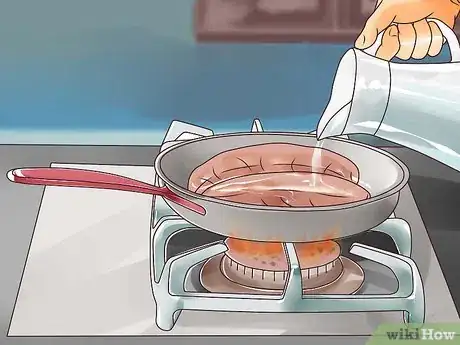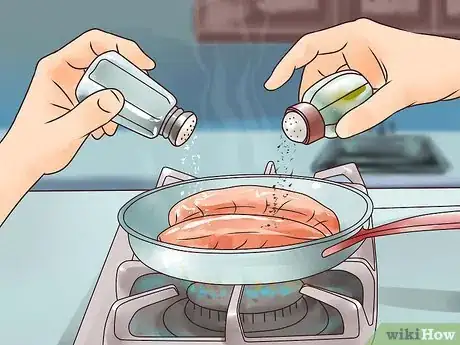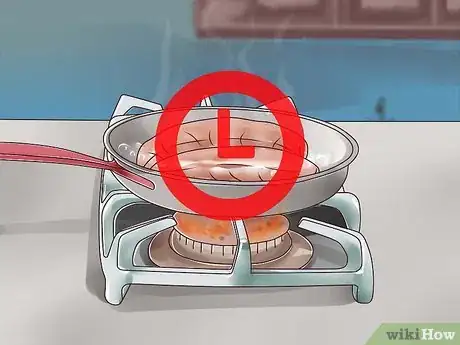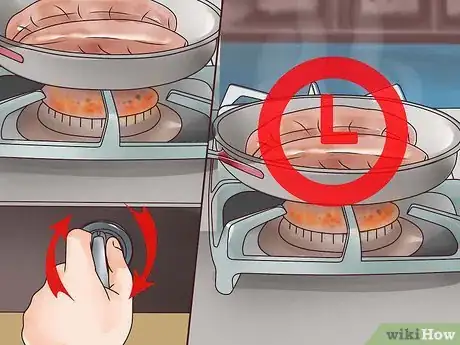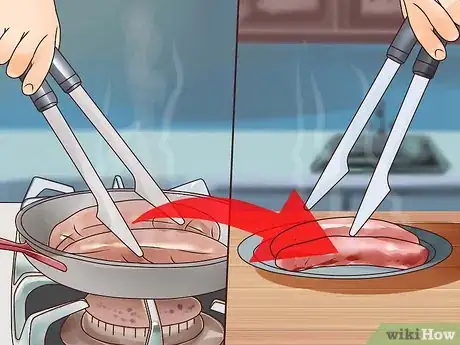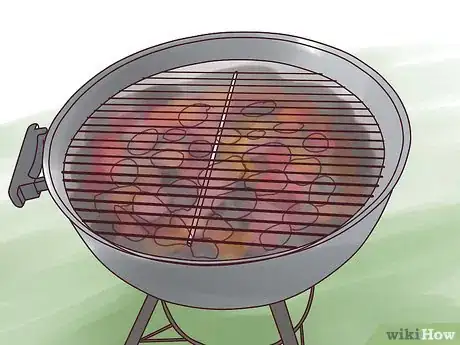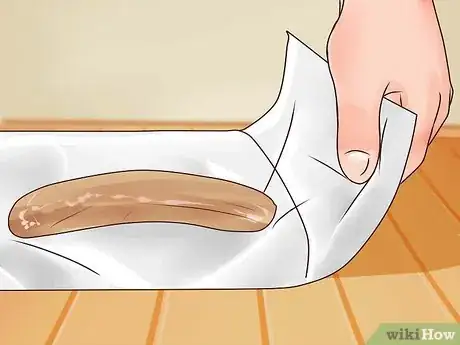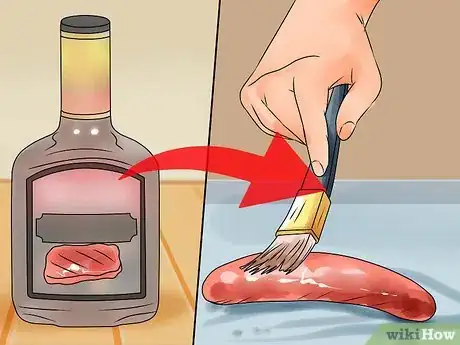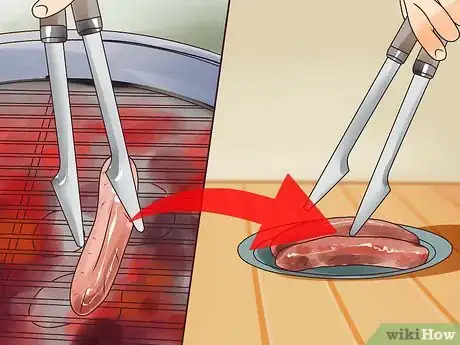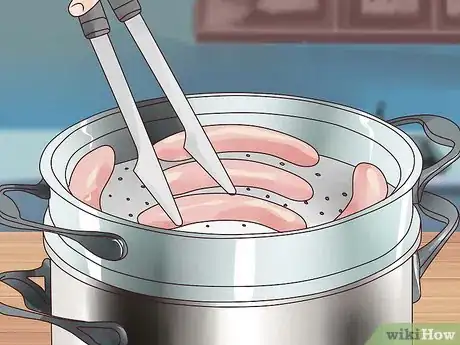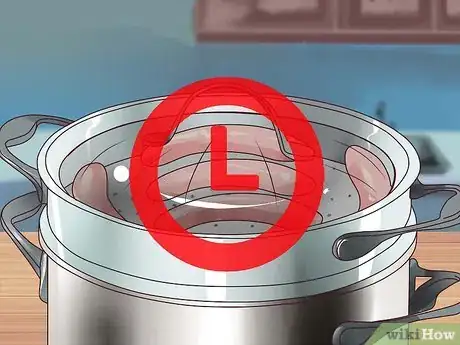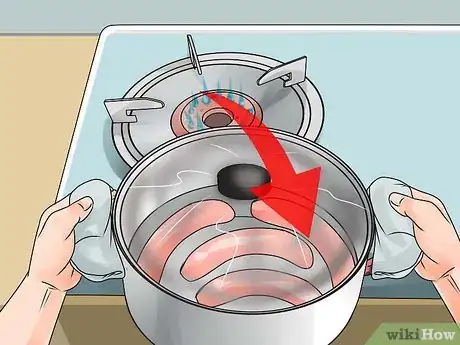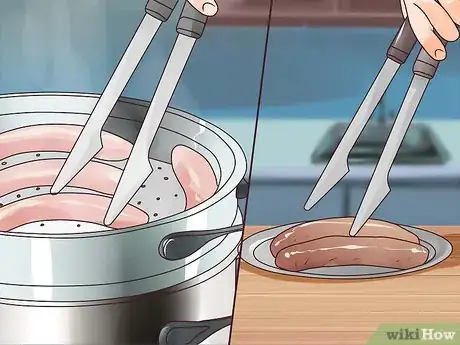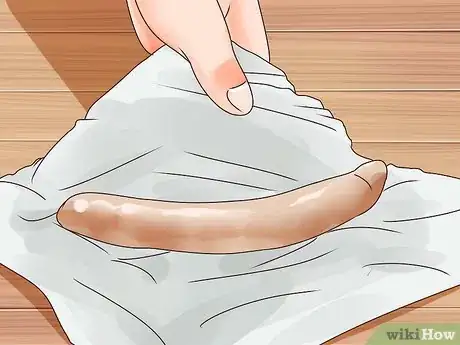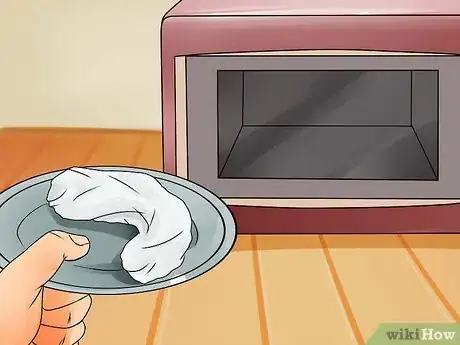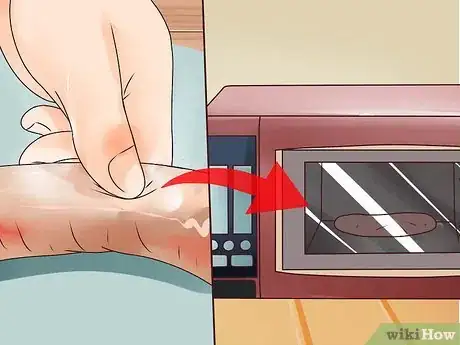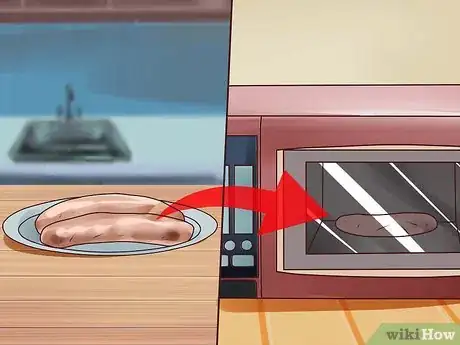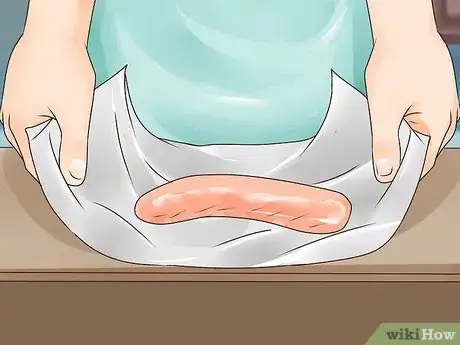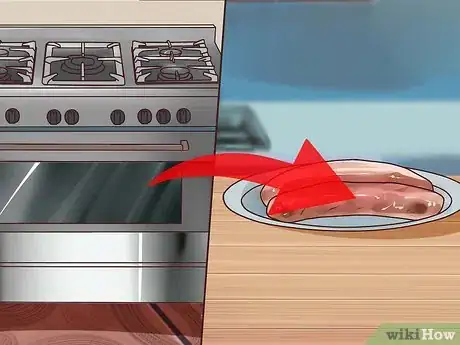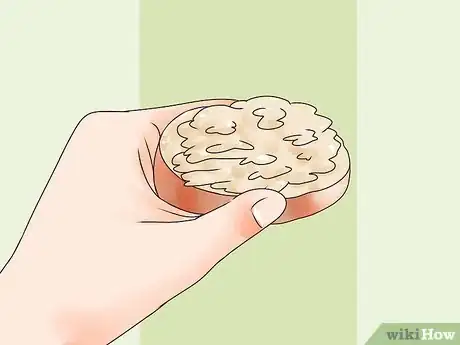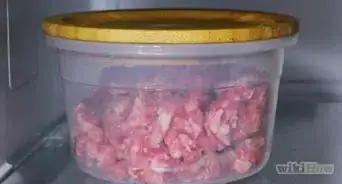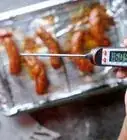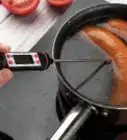X
wikiHow is a “wiki,” similar to Wikipedia, which means that many of our articles are co-written by multiple authors. To create this article, 9 people, some anonymous, worked to edit and improve it over time.
This article has been viewed 90,114 times.
Learn more...
Boudin is a spicy Cajun-style sausage made with pork and rice. The links are almost always pre-cooked when you buy them, so all you need to do is warm them up when you want to serve them. Even though you can serve boudin with other foods, it is most commonly served whole and on its own as a snack or appetizer.
Ingredients
Makes 4 servings
- 4 links pre-cooked boudin
Steps
Method 1
Method 1 of 2:
Part One: Reheating Boudin
Boiling or Poaching
-
1Place the boudin in a saucepan of water. Place a few links inside a medium saucepan. Add enough water to the pot to completely submerge the boudin.
- Make sure that there's room for the links to move around inside the water. Do not crowd the boudin, since doing so could result in uneven heating.
-
2Consider seasoning the water. If desired, add 1 tsp (5 ml) Cajun seasoning blend or 1/2 tsp (2.5 ml) salt and 1/2 tsp (2.5 ml) ground black pepper to the water.
- The boudin is already flavorful, so these additional seasonings are not necessary. Only add these seasonings if you prefer a stronger flavor than usual.
Advertisement -
3Boil for 5 minutes. Place the saucepan on the stove over high heat. Let the boudin cook at a full boil for 5 minutes.[1]
- Leave the saucepan uncovered.
-
4Let sit for 10 to 15 minutes. Reduce the heat down to low and let the boudin simmer gently for an additional 10 to 15 minutes.[2]
- As before, leave the saucepan uncovered.
- After the water cools, do not re-boil it. Doing so could cause the link casings to burst.
- The boudin is ready when it floats and takes on a spongy texture.
-
5Drain the water. Remove the links from the hot water using tongs and set them on a platter.
- Ideally, you should let the boudin rest 2 or 3 minutes before serving.
Advertisement
Grilling
-
1Preheat a grill to medium heat. Preheat a gas, electric, or charcoal grill for a medium range of heat.[3]
- For a charcoal grill, assemble a small pile of coals over the bottom of the grill. Light the coals, then wait for the flames to die down and a layer of ash to begin forming.
- For a gas or electric grill, set the burners to medium and give the grill a few minutes to heat up adequately.
-
2Consider covering the boudin with foil. If you prefer soft boudin links, wrap each link loosely in aluminum foil before placing it on the grill.
- Without the foil, this method will cause the casing to become crisp. Either option is acceptable. The choice is purely a matter of preference.
-
3Baste with barbecue sauce, if desired. If you want to enhance the flavor with your favorite barbecue sauce, baste the links before you begin cooking them.
- Brush the sauce over the links evenly and immediately before you place them on the grill.
- You can use a basting sauce regardless of whether or not you've wrapped the links in foil.
-
4Grill the boudin for 2 minutes per side. Place the links on the preheated grill and cook until heated through.[4]
- Use tongs to turn the links every 2 minutes.
- If you did not use the foil, you will be able to test for doneness simply by looking at the outer casing. When one side of the casing becomes crispy, that side is done.
-
5Remove the links from the grill. Use tongs to remove the heated links from the grill. Wait several minutes before serving.
- Wait several minutes before removing the foil, as well.
Advertisement
Steaming
-
1Cover the bottom of a steamer with water. Fill the steamer pan with just enough water to cover the bottom.
- Ideally, the amount of water should be 1/2 inch (1.25 cm) high or less.
- Note that a rice cooker could also be used for this process.
-
2Place the boudin inside. Arrange the boudin links in a single layer on the bottom of the steamer.
- The links should not overlap or touch one another. If you crowd them too much, they will not heat evenly.
-
3Heat the links for 3 to 5 minutes. Cover the steamer and set it on the stove over medium-high heat for 3 to 5 minutes.[5]
- If you have an electronic steamer instead of a stovetop steamer, you should use the "Cook" setting for this step.
-
4Let sit for 10 to 15 minutes. Remove the steamer from the heat. Keep the lid on and let the links sit in the steamer for another 10 to 15 minutes.
- When using an electronic steamer, switch it from the "Cook" setting to the "Warm" setting during this step.
- Do not remove the lid at any time during the heating process. Doing so will release the steam responsible for heating the boudin.
-
5Remove the links. Remove the fully heated boudin links from the steamer when ready to serve.
- Also note that the boudin links can stay warm and fresh for several hours when kept in this manner.
Advertisement
Microwaving
-
1Wrap one link with a wet paper towel. Wrap one boudin link in a layer of clean, wet paper towel.
- You could also use microwave-safe plastic wrap instead of the wet paper towel, if desired.
- This wrapping prevents the boudin from drying out in the microwave. It also prevents grease from splattering inside the microwave.
- Do not use a dry paper towel. The dry towel could act as a potential fire hazard.
-
2Microwave for 1 to 3 minutes. Place the boudin in the microwave and cook it on high for 1 to 3 minutes.[6]
- If the boudin has been previously thawed, 1 minute should be enough.
- If the boudin is fully or partially frozen, microwave it for 2 or 3 minutes.
-
3Turn and continue microwaving. Check the boudin. If the link is not yet done, turn it over and heat for another 1 or 2 minutes.
- When ready, the boudin will feel warm and spongy when squeezed.
-
4Repeat for each link. Repeat the same process for each boudin link. Once each one has been heated through, the boudin is ready to serve.
Advertisement
Baking
-
1Preheat the oven to 300 degrees Fahrenheit (150 degrees Celsius).[7] Meanwhile, line a baking sheet with aluminum foil.
- If using nonstick foil, the foil should be enough.
- If using standard aluminum foil, you should also spray the foil and the bottom of each link with nonstick cooking spray.
-
2Consider wrapping the boudin with foil. If you do not want the casings to become crispy, wrap each link individually in its own sheet of aluminum foil.
- Note that this foil will also need to be coated in nonstick cooking spray.
- Many consider the crispy casing to be one of the benefits of the baking method. If you prefer a crispier casing to a soft one, skip this step.
-
3Cook the boudin for 20 to 25 minutes. Place the boudin on your baking sheet and place the baking sheet in your oven. Cook until the boudin links are heated through.[8]
- Keep the links in an even, single layer to promote even heating.
- Use tongs to rotate the links every 5 minutes during the baking process.
- When ready, the links should be heated all the way through. If you did not cover the links with individual sheets of foil, they should also have crispy casings on all sides.
-
4Remove the links from the oven. Carefully remove the baking sheet from the oven. Let the boudin rest for a few minutes before serving it.
Advertisement
Method 2
Method 2 of 2:
Part Two: Serving Suggestions
-
1Squeeze or bite into whole links. The most common way to serve boudin is whole and as quick, tasty snacks.
- Many people describe boudin as a spicy pork and rice casserole stuffed into a casing. As such, it can be a very filling snack on its own.
- Typically, the casing is so tough that you would simply split it open and squeeze the stuffing out, directly into your mouth. You could use either your fingers or teeth for this.
- If the casing is thin enough, however, you may prefer to bite into the link little by little in the same way you would eat a sausage.
-
2Cut the links for use as appetizers. Boudin links can also be served as appetizers or Hors d'oeuvres. When presenting the links in this manner, use a sharp knife to cut each link diagonally into 1-inch or 2-inch (2.5-cm or 5-cm) slices.
- Slices of boudin can be served as a separate appetizer, but if you want to prepare something with more variety, you can place the slices on a larger platter with cubes of cheese and crackers.
-
3Prepare the links for breakfast. Boudin can be served at breakfast, just as other sausages are. Serve them alongside eggs and hashbrowns for a popular combination.
- For a slightly different twist, break open the end of the casing and squeeze the filling out using your fingers. Spoon this filling in between the two halves of a sliced bagel, biscuit, or croissant. Add scrambled eggs and cheese, if desired, and enjoy as a zesty breakfast sandwich.
-
4Serve the links in sandwiches. If you want to enjoy boudin as part of the main course at lunch or dinner, you can serve it with sandwich bread or buns.
- You can place a single link inside of a large hot dog bun and serve the boudin like a bratwurst. Garnishes may not be necessary since boudin is so flavorful on its own, but if you want to try something, consider barbecue sauce, hot sauce, onions, and banana peppers.
- Alternatively, you could arrange pieces of boudin on sandwich bread. Cut the boudin links into 1-inch (2.5-cm) diagonal slices using a sharp knife. Arrange these slices on one piece of bread, then top with onions, coleslaw, hot sauce, or any other desired toppings. Place the second piece on top and enjoy.
Advertisement
Things You'll Need
Boiling or Poaching
- Saucepan
- Water
- Seasonings (optional)
- Stove
- Tongs
Grilling
- Grill
- Aluminum foil
- Barbecue sauce (optional)
- Basting brush (optional)
- Tongs
Steaming
- Steamer
- Stove (optional)
- Water
- Tongs
Microwaving
- Wet paper towel or plastic wrap
- Microwave
Baking
- Oven
- Baking sheet
- Aluminum foil
- Nonstick cooking spray (optional)
- Tongs
References
- ↑ http://boudinlink.com/FAQ.html
- ↑ https://cajunoriginal.com/cooking-tip/how-to-cook-boudin/
- ↑ https://www.foodnetwork.com/recipes/amanda-freitag/grilled-boudin-and-creole-mustard-3213183
- ↑ https://youtu.be/J-IstbR4vkQ?t=90
- ↑ https://cajunoriginal.com/cooking-tip/how-to-cook-boudin/
- ↑ https://cajunoriginal.com/cooking-tip/how-to-cook-boudin/
- ↑ http://boudinlink.com/FAQ.html
- ↑ https://cajunoriginal.com/cooking-tip/how-to-cook-boudin/
- https://www.withhusbandintow.com/what-is-boudin/
About This Article
Advertisement
